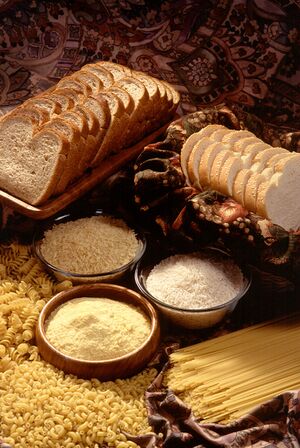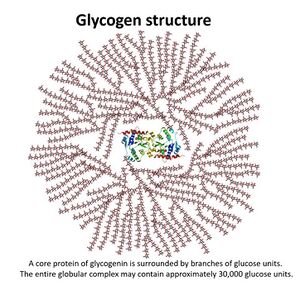Carbohydrates
Original Editor - Lucinda hampton
Top Contributors - Lucinda hampton and Kim Jackson
Introduction[edit | edit source]
Carbohydrates are one of the three macronutrients in the human diet, along with protein and fat. These molecules contain carbon, hydrogen, and oxygen atoms. Carbohydrates play an important role in the human body. They act as an energy source, help control blood glucose and insulin metabolism, participate in cholesterol and triglyceride metabolism, and help with fermentation. The digestive tract begins to break down carbohydrates into glucose, which is used for energy, upon consumption. Any extra glucose in the bloodstream is stored in the liver and muscle tissue until further energy is needed.
Image 1: Grain products: rich sources of carbohydrates
Carbohydrates is an umbrella term that encompasses sugar, fruits, vegetables, fibers, and legumes. While there are numerous divisions of carbohydrates, the human diet benefits mostly from a certain subset.[1]
Carbohydrate Classification[edit | edit source]
Carbohydrates are any foods that break down into glucose in the body. They are usually categorised into ‘simple’ and ‘complex’ carbs.
- Complex carbs eg brown rice and baked beans, contain more fibre and starch, meaning they digest slower. They should make up around a third of your diet.
- Simple carbs are made up of shorter chains of molecules, making them faster to digest. They include things such as some fruits, free sugars (like sweets and table sugar), fruit juice and white breads or pasta. That doesn’t mean never eat them, there’s a time and place for every food and when paired with fats, proteins or other complex carb sources, the digestion of simple carbs will slow.[2]
Image 3: Schematic two-dimensional cross-sectional view of glycogen: A core protein of glycogenin is surrounded by branches of glucose units. The entire globular granule may contain around 30,000 glucose units. Glycogen functions as one of two forms of energy reserves, glycogen being for short-term and the other form being triglyceride stores in adipose tissue (i.e., body fat) for long-term storage.
How Carbohydrates Fuel Exercise[edit | edit source]
Complex carbohydrates are an efficient source of energy that fuels muscle contractions. Once eaten, carbs are broken down into smaller sugars (glucose, fructose, and galactose) to be used as energy for immediate tasks. Any unused glucose is converted into glycogen and stored in the muscles and liver for future use.
- Glycogen is the energy source most often used for short, intense bouts of exercise eg sprinting or weightlifting. Because glycogen is stored in muscles, it is immediately accessible. During bursts of activity, the stored glycogen is converted back to glucose and burned for fuel. This is the typical energy source for the first few minutes of any sport.
- During endurance exercise, glycogen can also break down fat into something the muscles can use for fuel. Protein can also be broken down and used as a last resort, but this stresses the kidneys and limits the body's ability to build and maintain muscle tissue.
- Along side muscle contraction role, carbs also supply energy to the brain. If a person is not getting enough carbs during exercise they will likely feel low in energy or may experience a brain fog.
Consuming enough carbohydrates ensures a person has access to the energy needed for exercise. It also helps maintain mental sharpness for endurance sports[3].
Carbohydatrates and the Gut Microbiota[edit | edit source]
A complex relationship occurs in the intestine between the human gut microbiota, diet and the host.eg
- Shaping of the colonic microbiota is subject to the availability of microbiota-accessible carbohydrates (MACs) that are found in dietary fibre. Extreme ‘animal-based’ or ‘plant-based’ diets result in wide-ranging alterations of the gut microbiota in humans.
- Intestinal mucus also provides a source of carbohydrates to the gut microbiota.
- Colonic bacteria express carbohydrate-active enzymes, which endow them with the ability to ferment complex carbohydrates generating metabolites such as SCFAs. eg Three predominant SCFAs, are rapidly absorbed by epithelial cells in the GI tract where they are involved in the regulation of cellular processes such as gene expression, chemotaxis, differentiation, proliferation and apoptosis [4]
Research on carbohydrates and gut microbiota composition and functionality is fast developing and will open opportunities for prevention and treatment of obesity, diabetes and other related metabolic disorders through manipulation of the gut ecosystem[5]
References[edit | edit source]
- ↑ Holesh JE, Aslam S, Martin A. Physiology, Carbohydrates. Available: https://www.statpearls.com/articlelibrary/viewarticle/18843/(accessed 15.11.2021)
- ↑ Stylist Carbohydrates: why carbs are so important for exercise, recovery and brain function Available: https://www.stylist.co.uk/fitness-health/nutrition/carbs-health-benefits/537636(accessed 15.11.2021)
- ↑ Very well health What Do Carbohydrates Do? Available:https://www.verywellfit.com/how-carbohydrate-provides-energy-3120661 (accessed 15.11.2021)
- ↑ Thursby E, Juge N. Introduction to the human gut microbiota. Biochemical Journal. 2017 Jun 1;474(11):1823-36.Available:https://www.ncbi.nlm.nih.gov/pmc/articles/PMC5433529/ (accessed 16.11.2021)
- ↑ Chassard C, Lacroix C. Carbohydrates and the human gut microbiota. Current Opinion in Clinical Nutrition & Metabolic Care. 2013 Jul 1;16(4):453-60.Available: https://pubmed.ncbi.nlm.nih.gov/23719143/ (accessed 16.11.2021)









